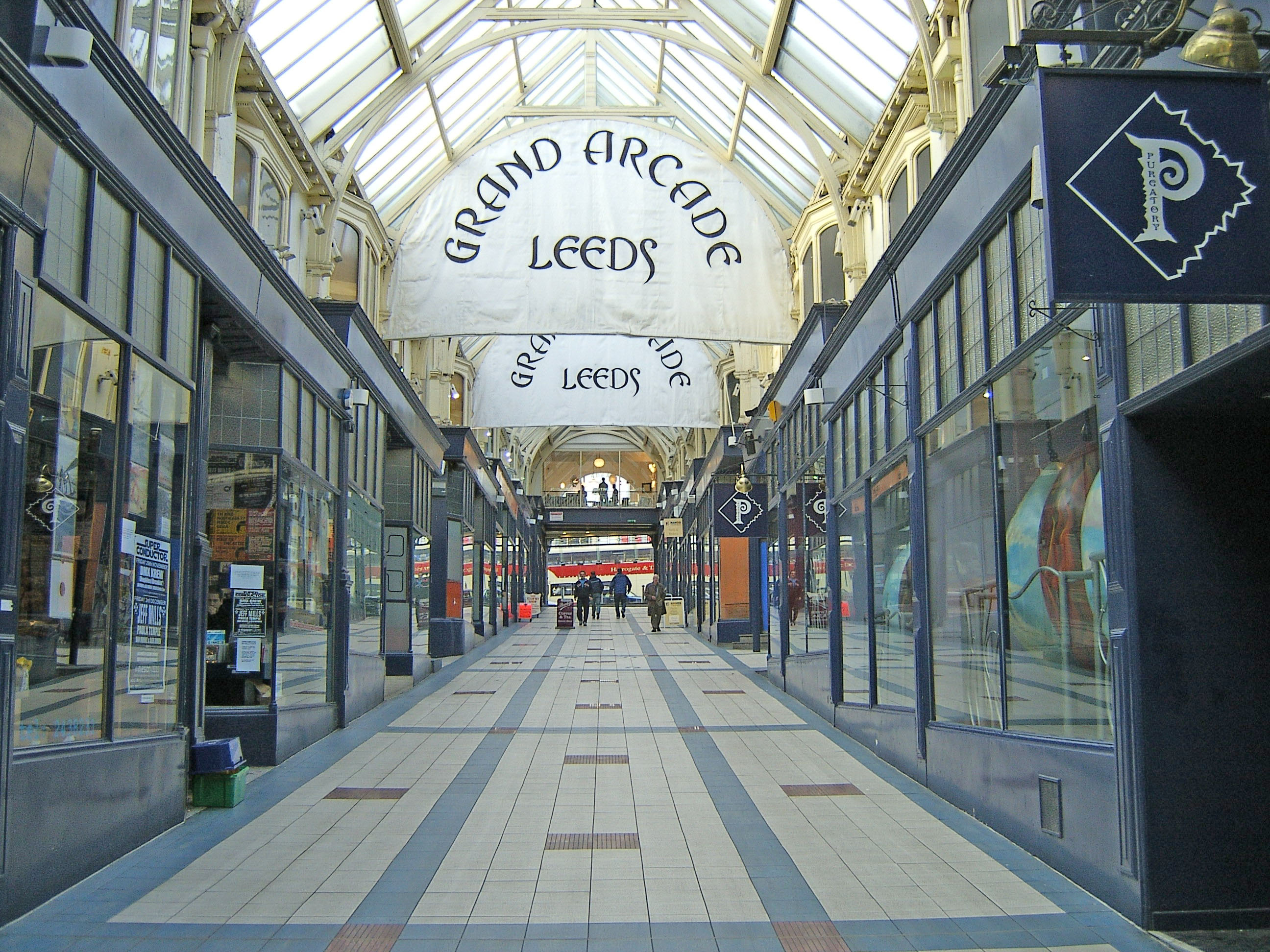Image Grand Arcade, Leeds, Gunnar Larsson via GNU Free Documentaion License
This week, individuals from local councils, town teams, business improvement districts (BIDs) and industry bodies will come together to share and learn from high street revitalisation success stories as part of the Future High Street Summit. The Summit, set up by retail expert and high street campaigner Clare Rayner in 2014, refutes claims that the ‘high street is dead’. It argues that far from being dead, it is instead ‘evolving’.
Looking at recent headlines, one would be forgiven for believing the high street was in terminal decline. For example, it was recently reported that in a study of multiple retailers across 500 towns, the net loss of stores in 2014 was nearly three times greater than in 2013 (987 compared to 371).
According to the Department for Business, Innovation and Skills, the main challenges facing the high street include:
- pressures on prices exerted by online retailers and large grocery stores;
- increased costs, including business rates, rents, and the introduction of the minimum wage;
- the ease and cost of starting an online business compared to a business on the high street;
- the digital delivery of some products (music, books etc) removing the demand for high street music shops.
- access and parking restrictions/costs in town centres
- the growth in ‘out of town’ retail parks and large supermarkets
- the lack of diversity, i.e. ‘Clone town’ syndrome
‘Showrooming’ – when shoppers look at products in store, then buy the product online from a different supplier – has also been identified as another potential threat to high street stores.
So given these challenges, does the high street really have a future?
According to Mary Portas it does. In her recent reflections on the progress made since her 2011 review of how government, local authorities and businesses could better promote the development of more prosperous and diverse high streets, she argues against predictions of the high street’s demise.
She cites research by Deloitte, which found that 38% of people still visit their high street almost daily, and that that a significant proportion of people continue to use their local high street, particularly to top up on groceries (59%), buy health and beauty, and pharmacy products (55%), and buy shoes and clothes (50%). She also notes that a significant number of people reported visiting the high street to use the library (44%).
Indeed, even the statistics show some cause for positivity. The Local Data Company, which publishes a ‘End of Year Vacancy Report’ in February each year, recently reported a downward trend in shop vacancy rates, from 14.5% in February 2012, to 13.4% in May 2014 – the lowest rate since 2010.
Commenting on these figures, Clare Rayner, organiser of the Future High Street Summit, notes:
“Figures from LDC/bira show that high street vacancy rates have dropped a little; but the national averages mask the detail, which interestingly shows that there has been a net gain in independents and a loss in multiples. To me it’s clear that smaller businesses and independent retailers are the ones who are keeping our high streets alive – so it is essential they get the support they need from the relevant authorities and place managers.”
So what can high streets do to support independent retailers?
In Rotherham, Mary notes that mystery shoppers have been used to help local businesses improve their standards, by providing advice on quality, store layout and pricing. Local shop owners have been offered social media training, and there has been a ‘shop local’ campaign, showcasing the range of independent shops available. A ‘pop up high street’ has also been run at various locations, including council offices, retail parks, hospitals and local events, and town centre parking charges have been frozen.
BoxPark is another great example of support for small independent shops. It is a ‘pop up shopping mall’ in Shoreditch, London, created entirely from containers, and houses a variety of different independent retailers, artists and craftspeople.
In his book, ‘How to save our town centres: a radical agenda for the future of high streets’, Julian Dobson highlights Handpicked Hall, in Leeds, as a key example of good practice. Set up in October 2012 in a vacant department store, it opened up the space to a host of local producers, including “craftspeople, artists, food makers, fashion designers, a woman who wanted to open a vintage tea salon and even a man selling carnivorous plants. People that wouldn’t fit within a traditional market and couldn’t afford to kit out a shop of their own… None could have borne the cost of trading in a traditional high street shop.” (Dobson, 2015:109).
Unfortunately, Handpicked Hall closed in 2014, however, the majority of the retailers within it moved into the Grand Arcade. According to local business owner, Claire Riley, co-owner of Our Handmade Collective, “Taking the empty units within the Arcade has actually turned a forgotten and empty shopping arcade around, and we’re now proud to call the Grand Arcade the Home of the Independents.”
As well as support for local independent retailers, the high street also needs to evolve to address the challenge of e-commerce. According to Mark Hudson, retail leader at PWC, “The future can be seen by watching the ‘digital natives’ at work and play – those who have grown up with online shopping, mobile phones and ubiquitous broadband have a very different relationship with traditional high streets than the previous generations. Rather than try to recreate the past, the high street needs to evolve to be relevant to the future.”
In Ashford, they have sought to address this challenge by using technology to promote the town centre. They aim to develop a ‘digital high street’, which will take the format of an innovative website and app that will guide visitors through the town, providing special offers, and ‘click and collect’ features for all the businesses.
Of course, the high street has an importance far beyond retail. It also has a wider role providing services and meeting places, including libraries, health centres, tourist information centres, bus and rail stations, education centres, post offices, workspaces and meeting rooms.
Recent examples of such high street services include the relocation of Dorking library to the high street, the provision of creative craft classes in Leeds, meeting space for mothers and their children in Bristol, workspace for artists in London and short term respite services for children with disabilities in Bristol, Cheltenham and Swindon.
As Julian Dobson notes: “A high street, and wider town centre within which it sits, is far more than simply a collection of parcels of individually or publicly owned land, shops and highways. It is the heart that keeps a place alive.” (Dobson, 2015:256).
Sharing and learning from good practice, through events such as the Future High Streets Summit and the Great British High Street competition, is a key way of ensuring that the high street remains very much alive and relevant for the foreseeable future.
The Idox Information Service can give you access to a wealth of further information on regenerating high streets, to find out more on how to become a member, contact us.
Further reading
Propping up the market? (temporary retailing), IN Estates Gazette, No 1505 7 Feb 2015 (A53773)
Digital High Street Advisory Board (2015) Digital high street 2020 report (B41351)
Dobson, J (2015) How to save our town centres: a radical agenda for the future of high streets. London: Policy Press. (B41359)
PricewaterhouseCoopers (2014) The changing face of retail: where did all the shops go? (B37238 )
Resurrecting the high street (regenerating town centres), IN Local Government Executive, 16 Oct 2014 (A52351)
Town Teams, Portas Pilots and the future of the high street, IN Journal of Urban Regeneration and Renewal, Vol 7 No 3 Spring 2014 (A49469)
Institute for Retail Studies (2014) Town centre and high street reviews (The Retail Planning Knowledge Base briefing paper) (B38740)
Wrigley, N and Lambiri, D (2014) High street performance and evolution: a brief guide to the evidence (B38664)
Mayor of London (2014) Learning from London’s high streets: a collection of essays, case studies, learning and inspiration (B38523)
Future High Streets Forum (2014) Good leadership: great high streets (B37725)
IDOX (2014) Town centres in Scotland: changing policy and practice (In focus) (B37581)
Share
Related Posts
Supporting residents on the decarbonisation journey: leveraging data for effective retrofit projects
As the drive towards decarbonisation intensifies, the social housing sector’s ability to collect, store and manage vast amounts of data becomes increasingly critical. With a shared goal of creating warmer, carbon-free homes, housing associations’ strategic use of data is essential ....
A recent item on BBC Radio 4’s Today programme generated an unusually high number of responses from listeners. A man who had lost his job in the financial services sector at the age of 57 described his difficulty in trying ....
Tackling geographical inequalities is critical for ensuring that all parts of the country have the potential to prosper. When the UK was a member of the European Union, it was entitled to a share of funding from the EU’s structural ....


